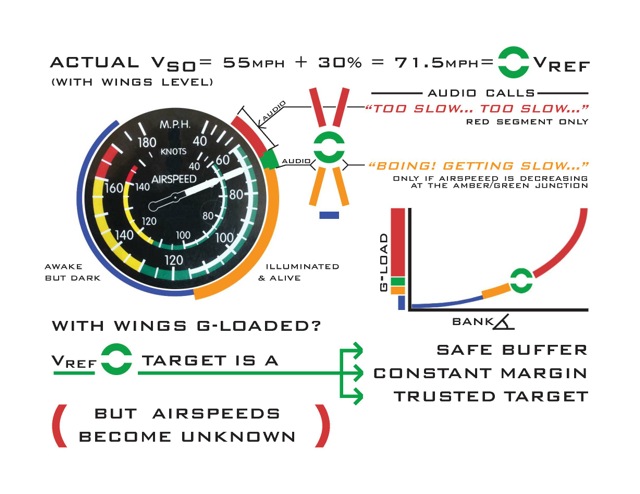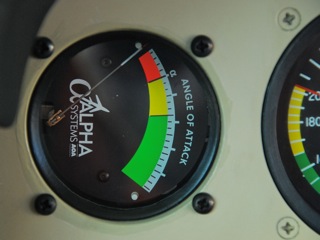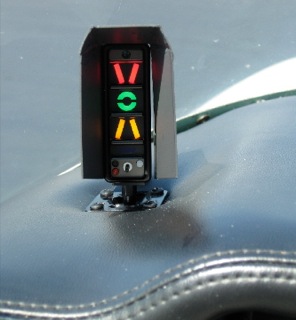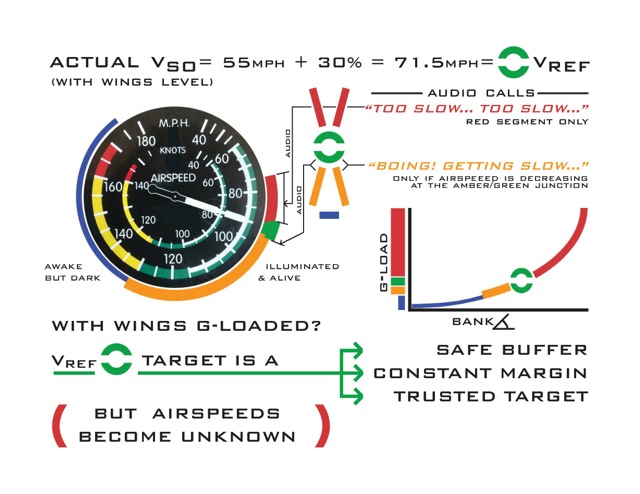|

Angle of Attack
How to Calibrate? How to Fly?
(Click here to go back to the start of our AoA pages)
Bruce Landsberg at the AOPA Air Safety Foundation writes in "Spinning In" on Feb 2003: "The FAA's Small Aircraft Directorate...looked at more than 1,700 stall/spin accidents dating back to 1973 and concluded that 93 percent of those airplanes were at or below pattern altitude — too low for spin recovery...." A good many pilots might say... "they got too slow". But--especially for stalls in the pattern--I'm not so sure that's correct.
Consider, please (and remember: I AM NOT A CFI)...
Is it “Too Slow”? ... or... Could it be “Too Fast”?
I have a personal theory that we are flying too fast in the traffic pattern. I believe that extra speed is what is killing pilots...and most of these are very experienced pilots. It is NOT that they are getting too slow.
Instead, it may be that they are very aware of the G-Force vs. Angle-Of-Bank curve---but uncertain what margin above stall remains at that temperature, that altitude, that day, and at that weight---and so they pad the book speeds [5kts for gusts, two more for one’s wife, two more for the kids, six for circles, ten for Telluride, etc.] to the point that they are too fast when they initiate the downwind to final series of turns.  I know have done it, then chastized myself later: "That wasn't the best you can do..." I know have done it, then chastized myself later: "That wasn't the best you can do..."
Now all this may be just fine if we widen out the pattern to fly a wider ground track, but in the case where (by habit, perhaps?) we fly the downwind leg with a close-in offset from the runway, we set up a possible overshoot, especially during the turn to Final. Any extra speed results in a much wider-than-normal turn radius...and an overshoot.
Then ... an unhealthy human tendency to “get there” by banking a "just a bit more" and pulling up-elevator -- to avoid getting low -- results in overly steep banks and a wing-loaded accelerated stall at low level. Unsurvivable.
But suppose the pilot were more precisely aware of how close s/he was to an incipient stall? An Angle of Attack (AoA) display can tell us exactly how much margin above stall remains. Then, having that assurance and comfort level, we can FLY SAFELY SLOWER and the turn radius decreases significantly.
Two displays can help with that: the Mechanical AoA display is very simple and entirely mute. While it is true that one must be looking at it to reap any benefit, it's a great visual device; it helps us "see the air". The Enhanced Legacy AoA Display is aerodymanically similar, yet much more capable; and it talks to us--much as the Pilot Not Flying might--even if we are looking out the window. Nice.
SETTING UP the MECHANICAL DISPLAY.  We suggest that you calibrate it like a ABS member has done here in his Bonanza (He's a US Naval Aviator at Leemore NAS) so that
the Greek letter Alpha (it's at the Red/Yellow transition) is set at a considerable margin prior to stall (~1.2Vso to ~1.3Vs.). THAT Optimum Angle of Attack (OAA) gives you a repeatable known margin, a repeatable known buffer, and at THAT Alpha point...you will not stall. We suggest that you calibrate it like a ABS member has done here in his Bonanza (He's a US Naval Aviator at Leemore NAS) so that
the Greek letter Alpha (it's at the Red/Yellow transition) is set at a considerable margin prior to stall (~1.2Vso to ~1.3Vs.). THAT Optimum Angle of Attack (OAA) gives you a repeatable known margin, a repeatable known buffer, and at THAT Alpha point...you will not stall.
Needle high? Push it down.
Needle low? Pull it up.
So that means your very Short Final segment will be flown just slightly into the red zone above OAA, with a smaller stall margin. That's surely exactly the way you "fly short" now. Could you adjust the OAA, later on ... as you get to know the device? (Perhaps even set very close to stall, for a very specific purpose, such as in very tight bush pilot Ops?). Of course. But whatever target you choose, be sure to placard the setting, so the next pilot will know to what Alpha it's calibrated, in relation to stall.
SETTING UP the ENHANCED LEGACY DISPLAY ("Enhanced" means it includes an Aural Early Warning by "Slow Sarah" or the "Deedle-Deedle" tone) . This is a more sophisticated device, designed for early stall warning as well as precision flying. Think of it as a real-time Vref calculator. The reference ... Vref ... is the green Donut (it's blue in later models) seen here.  The display is arranged fairly intuitively - a bifurcated Donut in the middle ("ON SPEED; at Vref"), an amber chevron on the bottom ("You're OK, just a bit faster than Vref") and a red chevron on the top ("Danger Zone"). [Here, the display is in Self-Test and all segments are illuminated. In flight, we'd see only one or two segments.] The display is arranged fairly intuitively - a bifurcated Donut in the middle ("ON SPEED; at Vref"), an amber chevron on the bottom ("You're OK, just a bit faster than Vref") and a red chevron on the top ("Danger Zone"). [Here, the display is in Self-Test and all segments are illuminated. In flight, we'd see only one or two segments.]
The Enhanced (meaning: "tones or voice alerting") Legacy AoA can help us when we are not even looking at it. A voice callout can alert our distracted brains with a "Getting Slow" and if that alert should occurs at about 40% above stall, that's good enough. Later, when much closer to stall, we'll hear a lady's quiet voice "Too Slow"..."Too Slow"..."Too Slow"
We suggest that you calibrate the AoA so that
the Donut is set at a considerable margin above stall (~1.2Vso to ~1.3Vs.). That Optimum Angle of Attack (OAA) gives you a repeatable known margin, a repeatable known buffer, and at that Alpha point...you will not stall. It also makes the Donut into a really good Vref target for manevering.
In my King Air, I set my electronic "AoA Cruise" calibration point to the top end of the Flap Arc. This Alpha point keeps the display dark in high speed cruise (140-210+KIAS ... when I don't need it) and it also compresses the range of each Legacy AoA light segment, making the device more precise, and easier to fly. In my ~270KTAS King Air, the Legacy ambers only comes alive at the top of my full flap range, which gives me a green donut at a range of 108KIAS to 100KIAS, wings-level. There is no magic in that choice, nor is it "right" or "wrong"; it's simply my preference.
How do we FLY The AoA? I use the AoA display as a real-time Vref calculator. There is no need to open the POH and to dig into to the performance section to calculate Vref; there is no need to factor in abnormal G-loads due to steep banks. The AoA indicator calculates Vref for us immediately and continues to provide accurate information throughout the flight, and on successive flights.
An AoA is especially useful in a steeply-banked turn, or when I need to fly a tight radius circle, or during a short field landing. Here's what tbe G-Load vs Bank graph and AoA look like in a steep bank:
I'll glance at the AoA display, quickly crosschecking the ASI and noting my Airspeed fast/slow vs. the Vref Optimum Alpha. If necessary, I'll make a correcting pitch input so as to re-center the Donut on the target OAA, and then scan back to use the primary instrument--the ASI--(while staying at that same bank angle) to retain the "sure thing", the assurance...to confirm that the margin above stall remains available
So: the ASI is always the primary instrument; the AoA is the Vref calculator. Does that logic appeal to you?
But, if I change the bank? I'd just re-check the AoA, and re-set my mental AirSPEED target ... AirSPEED is the certificated primary indicator; AoA is very good info, but only advisory. That's important. The FAA states the same points in their excellent .
Simple enough. Cross-check AoA with Airspeed being the primary reference. Works for me. (Can you see how the wing loading changes the Speed target but not the AoA target?) Finally...if the pilot gets distracted and fails to cross check AoA, "Slow Sarah" quietly announces [click to hear her] "Getting Slow". Hard to ignore, isn't she? That is the value of the enhanced AoA.
But if there is a better way to fly Alpha, I'd sure like to learn about it.
NEVER FORGET that a AoA Display will NOT improve any aircraft's performance, not even a little bit! But an AoA will provide sufficient additional information to give the pilot confidence to operate safely closer to the airplane’s limits and...
...
an AoA will enable a pilot to extract all--or, at least: far more of--the airplane's available performance. An AoA can definitely make a good pilot better and enable him to fly more precisely.
Reading this site, you have no idea whether my opinion matters, so you decide: I am a ~6,000 hour Commercial, Instrument, Float Plane pilot, typed in the Cessna CJ-1 (with an AoA display), and currently fly my King Air 90 Blackhawk (with the "Eagle" AlphaSystemsAoA).
I learned to fly near my New River NC Marine Corps base at a small grass strip; I was privileged to hangar-chat with dozens of active duty Marine pilots to whom AoA was perfectly normal, so I assimilated a bit of their AoA know-how long ago.. I operated my Bonanza 36 (for its 20+ years with me, it had a simple but effective mute AoA display), and two Barons off my private airport, a 3,000 foot sloping, curved grass runway.
I am not a CFI, not an aeronautical engineer, nor am I a teacher. I offer you only my experience ... from Alaska's Prudhoe Bay, and all of Canada, north to 2,500-3,000 ft. gravel runways on Baffin Island, over to Greenland, and to the far southeast Caribbean, Mustique, a tiny runway in a valley, very short. In fact, ANY manuvering flight regime becomes much more comfortable, and especially so as a pilot approaches the margins of the aircraft's flight envelope. If one knows AoA, and is AoA-equipped, then these places and manuevers are easy...and safer.
Disclaimer: The information provided in this website and AoA/Aircraft portion is provided free of charge. All information provided on this web site is provided 'AS IS'. No guarantee is provided for the accuracy of the information or the application of the information provided herein. I accept no responsibility or liability with regards to the accuracy or currency of the information provided. By using, reading or accessing this web site, you agree to be the user of the information provided. The user accepts full responsibility for all information provided. Although I try to keep the information on this site current, there is no guarantee that the reference materials or the material on this site is correct. This information is provided entirely in the spirit of helpful cooperation.
Neither Tom Rosen, nor I, nor anyone who helped us with this research (each one helping entirely at their own expense) has ANY financial interest, now or ever, in ANY Angle of Attack manfacturer or in ANY AoA product line. Period.
Incidentally, here's a summary of regulatory guidance clearly indicating that installation of an independent secondary advisory AoA like the "Legacy" is a "minor alteration" on the vast majority of light general aviation aircraft and here is a list of all the AoA manufacturers that I'm aware of.
Newly-published magazine articles, Spring & Summer 2011
Click here to begin a review of "Thoughts from those who know
|






